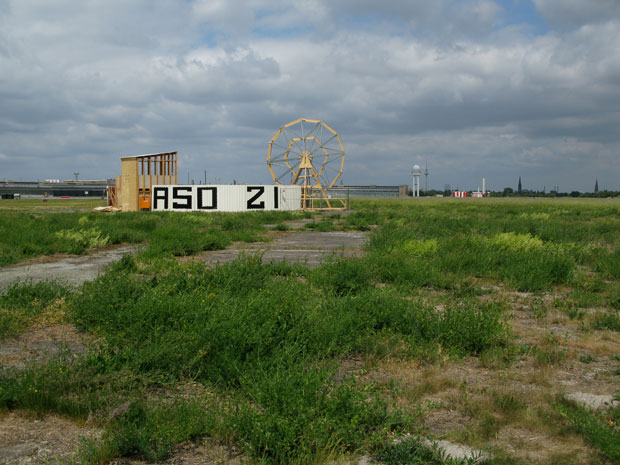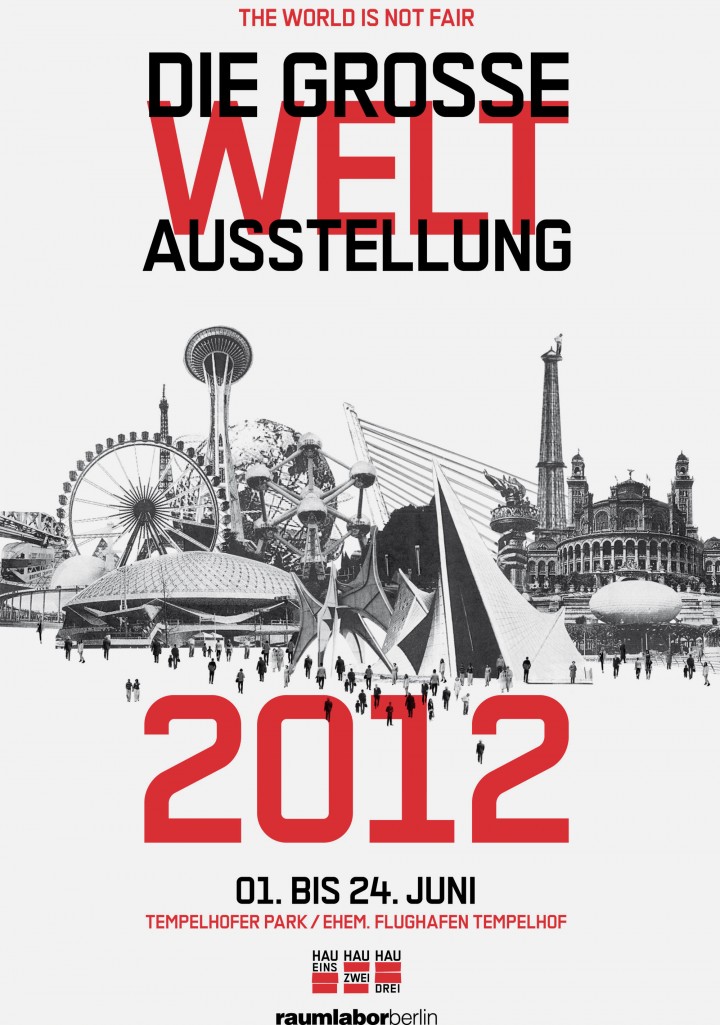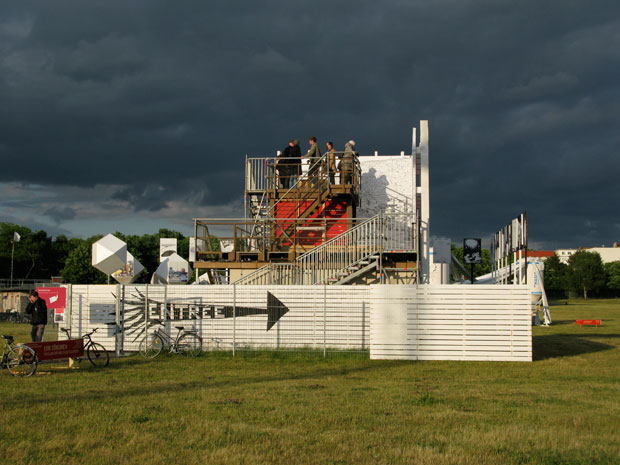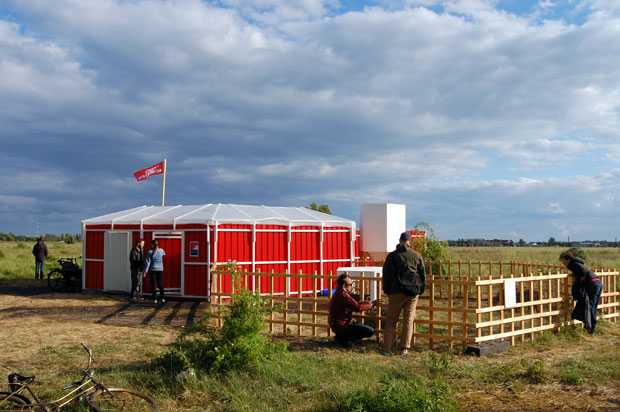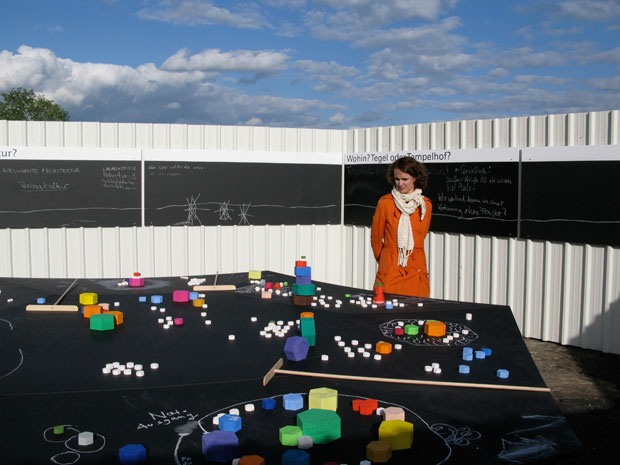the great worlds fair 2012
Eine Kooperation von Hebbel am Ufer und raumlaborberlin
Gefördert durch Hauptstadtkulturfond, Stiftung Deutsche Klassenlotterie Berlin, Schering Stiftung.
In Kooperation mit Grün Berlin und IGA Berlin 2017
The Greate Worlds Fair 2012 (Die Große Weltausstellung 2012) is an exposition in 15 pavilions spread across the vast airfield. The project is our statement to the ongoing discussion about the future of the site. Together with HAU (Hebbel Theater Berlin) we´ve invited 15 directors, architects, installation- and performance-artists. They each developed a work for the site and for a pavilion designed by raumlabor

The architecture of the 15 pavilions can be understood as a contribution to a discussion about sensibly managing resources. A third of the exhibition spaces involve reformations of structures that already belong to the existing facilities of the former airport field. Other structures will be erected from modules that were used in the summer of 2011 at the festival “Über Lebenskunst” at the Haus der Kulturen der Welt. Only three pavilions are new structures, and these only to a limited degree.
Unter ironischer Bezugnahme auf die Tradition der Weltausstellungen und der »Expos«, die seit mehr als 160 Jahren weltweit an wechselnden Schauplätzen ausgerichtet werden, standen vom 1. bis zum 24. Juni auf dem Gelände des ehemaligen Flughafens Tempelhof in Berlin, ein Ausstellungsparcours mit 15 Pavillons zur Erkundung bereit. Diese Pavillons verstehen sich nicht als Agenten der Markenbildung von Nationalstaaten, sondern als Orte höchst subjektiver künstlerischer und politischer Reflexion. Über die Grenzen kultureller Disziplinen hinweg suchen Architekten, Theatermacher, Performer, Bildende Künstler die Auseinandersetzung mit Ideen, Systemen und Phänomenen, über die noch die entlegensten Kulturen miteinander global verbunden sind. Gezeigt wird nicht die Welt, wie sie sein wird oder sein soll, sondern wie wir sie wahrnehmen, verstehen, interpretieren.
Die Architektur der 15 Pavillons versteht sich als Beitrag zu einer Diskussion um den sinnvollen Umgang mit Ressourcen. Bei einem Drittel der Ausstellungsräume handelt es sich um Überformungen von Bauten, die zum Bestand des ehemaligen Flugfeldes gehören. Weitere Gebäude werden aus Modulen errichtet, die im Sommer 2011 beim Festival »Über Lebenskunst« im Haus der Kulturen der Welt zum Einsatz kamen. Bei lediglich drei Pavillons, und auch das nur bedingt, handelt es sich um Neubauten.
The “Pavilion of World Fairs” by Erik Göngrich is a sculptural space that opens up overlapping views onto the world fairs, which have been taking place now for more than 160 years. A 40 square meter large drawing assembles a variety of aspects and histories concerning 28 selected world fairs. It is shown that urban development with and for large-scale events is no longer timely and has usually taken place without regard for the history of a city and its inhabitants. The outer wall of the pavilion will display 40 drawn posters, on which historical mottos from former world fair can be seen, contrasted with slogans that polemically point out topics and questions of the future that have so far remained unconsidered.
Der „Pavillon der Weltausstellungen“ von Erik Göngrich ist ein skulpturaler Raum, der einander überlagernde Blicke auf die seit mehr als 160 Jahren stattfindenden Weltausstellungen eröffnet. Eine 40 Quadratmeter große Zeichnung versammelt eine Vielzahl von Aspekten und Geschichten zu 28 ausgewählten Weltausstellungen. Gezeigt wird, dass Stadtentwicklung mit und für Großveranstaltungen nicht mehr zeitgemäß ist und meist ohne Rücksicht auf die Stadtgeschichte und die Bewohner stattfand und stattfindet. An der Außenwand des Pavillons sind 40 gezeichnete Plakate angebracht, auf denen historischen Losungen früherer Weltausstellungen zu sehen sind, kontrastiert durch Slogans, die bislang unberücksichtigt gebliebene Themen und Fragestellungen der Zukunft polemisch zuspitzen.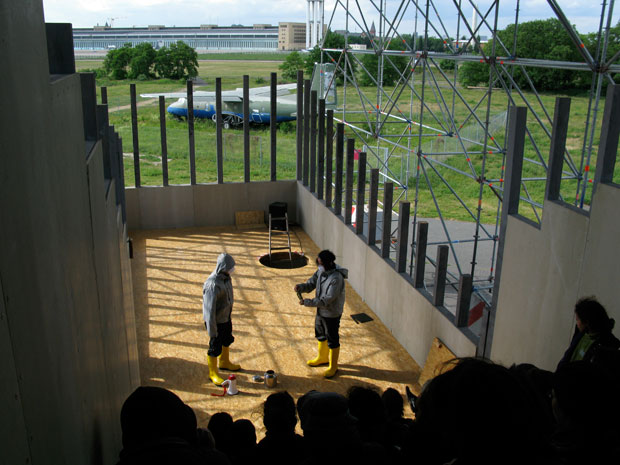
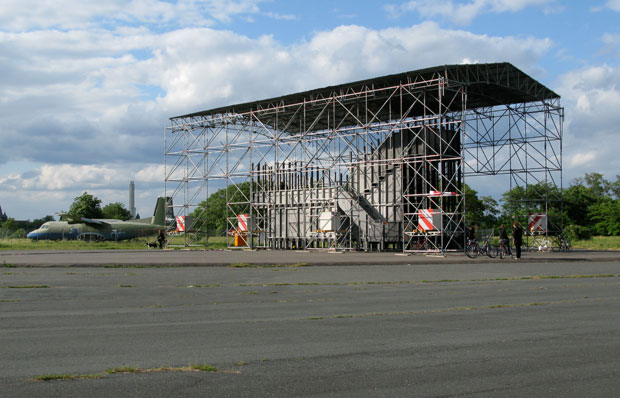
In an architectural structure reminiscent of the damaged reactor blocks in Fukushima, the director Toshiki Okada, who comes from Yokohama, together with his theater troupe chelfitsch, examines the abstraction and immeasurability of the catastrophic events in a language of reduced gestures and limited words.
In einer Architektur, die an die havarierten Reaktorblöcke in Fukushima gemahnt, nähert sich der aus Yokohama stammende Regisseur Toshiki Okada gemeinsam mit seiner Theatergruppe chelfitsch in einer Sprache reduzierter Gesten und knapper Worte der Abstraktheit und der Unermesslichkeit katastrophischer Ereignisse.
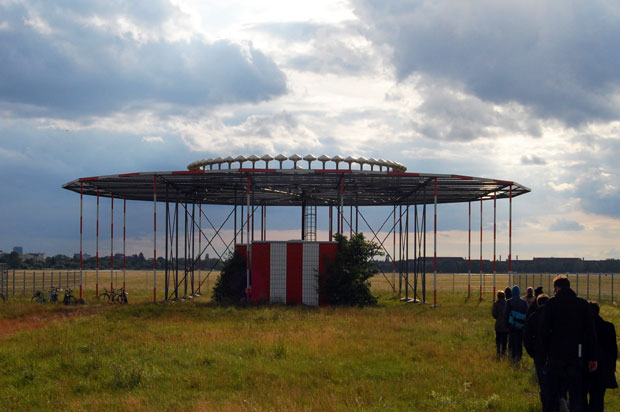
Hans-Werner Krösinger, one of the earliest representatives of contemporary documentary theater, conceives a living sound installation in an antenna building, focused on the military use and history of forced labor at the former Tempelhof Airport
Hans-Werner Krösinger, einer der führenden Vertreter des zeitgenössischen Dokumentartheaters, konzipiert in einem Antennengebäude eine belebte Klanginstallation, die sich mit der militärischen Nutzung und der Geschichte der Zwangsarbeit auf dem ehemaligen Flughafen Tempelhof beschäftigt.
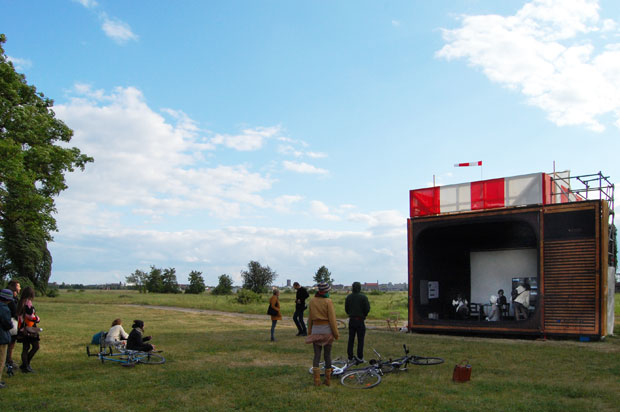
Die Videokünstlerin, Performerin und Aktivistin Tracey Rose inszeniert mit Hilfe von Laiendarstellern eine sich über den gesamten Austellungszeitraum erstreckende Seifenoper. Als Bühnenbild dient ihr die überdimensionierte Nachbildung eines Schwarzweißfernsehers der Marke Blaupunkt, der ihrer Familie in Südafrika zu Zeiten der Apartheid einen Zugang zum Weltgeschehen eröffnete.
The video artists, performer, and activist Tracey Rose, with the help of non-professional actors, puts on a soap opera stretched out over the whole span of the exhibition. As a stage, she uses an oversized reconstruction of a black-and-white Blaupunkt television, which had provided her family in South Africa with access to world events during the Apartheid period. 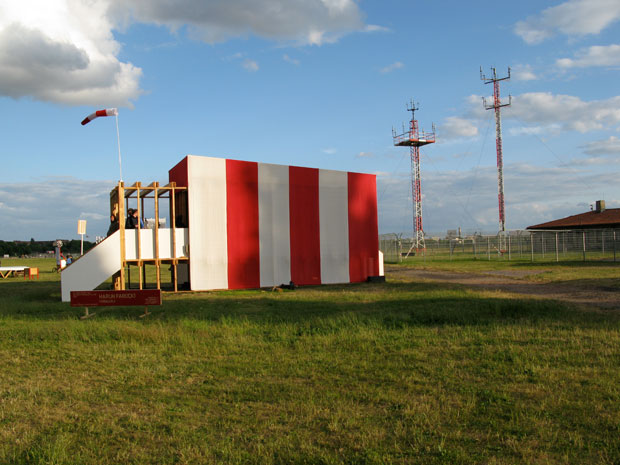
Der in Berlin lebende Filmemacher Harun Farocki zeigt den ersten Teil eines auf mehrere Jahre hin ausgelegten Rechercheprojekts mit dem Titel »Vorbild/Nachbild«, das die Rolle von Computeranimationen für Simulationssysteme und prognostische Dienstleistungen erkundet. Es geht um die globalen Kreisläufe von Luft, Feuer und Wasser – und das Verlangen nach der Beherrschbarkeit einer Welt, die von einer wachsenden Unsicherheit im Hinblick auf die Vorhersagbarkeit systemisch bedingter Ereignisse geprägt ist.
Berlin-based filmmaker Harun Farocki shows the first part of a long research project with the title “Vorbild/Nachbild,” which examines the role of computer animation for simulation systems and prognostic services. It concerns the global circulation of air, fire, and water–and the demand to control a world that is marked by a growing instability in relation to the predictability of systematically defined events.
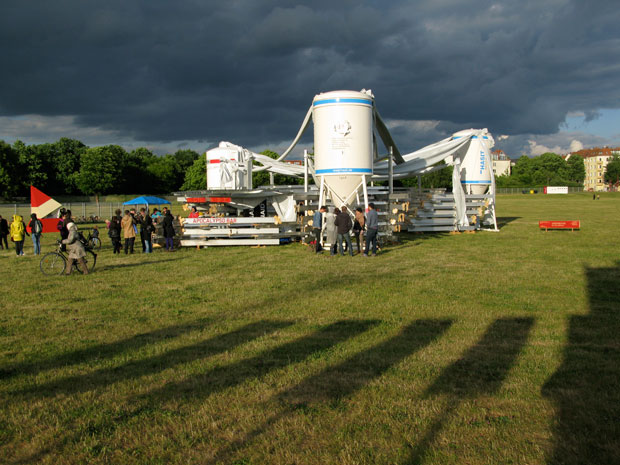
Das Stuttgarter Architektenkollektiv Umschichten hat aus vorgefundenen Materialien ein Festivalzentrum gebaut, dass für drei Wochen entsteht ein hybrider kultureller Raum fungierte. Er diente den Besuchern von »The World Is Not Fair – Die Große Weltausstellung 2012« als Ort der Begegnung und des Austauschs, aber auch als Veranstaltungsstätte. Hier wurde ein umfangreiches Begleitprogramm mit Vorträgen, Diskussion, Filmvorführungen und Konzerten präsentiert.
The Stuttgart architecture collective Umschichten build a festival center from found materials, that for three weeks funktiones as a hybrid cultural space. It served as a place of meeting and exchange for the visitors to “The World Is Not Fair–The Great World’s Fair 2012,” but also as a venue for events. A comprehensive program of lectures, discussions, film screenings, and concerts was presented here.
Assuming that the artists that are flocking to Berlin stay in the city and grow old here–what to do with these aging artists in 30 or 40 years? The “Camp of the Renegades” by Dellbrügge & De Moll is a housing project for elderly artists. We see the pavilion as the first module of a colony under construction.
Angenommen, die Künstler, die nach Berlin strömen, bleiben in der Stadt und werden hier alt – wohin dann mit den Kunstgreisen in 30 oder 40 Jahren? Das „Camp der Renegaten“ von Dellbrügge & De Moll thematisiert ein Siedlungsprojekt für alternde Künstler. Der Pavillon versteht sich als erstes Modul einer im Aufbau befindlichen Kolonie versteht.
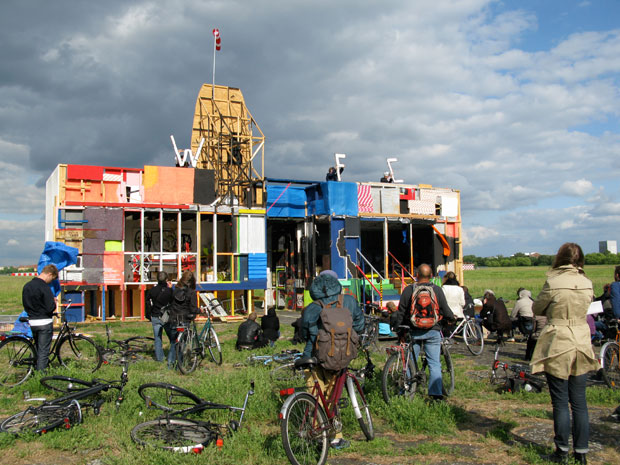
The theater collective andcompany&Co., in collaboration with the visual artist Jan Brokof & friends, set up the “World Freud Center,” a hybrid site operating simultaneously as stage, as exhibition space, and as practice for uncovering and treating disturbed psycho-social contexts. Desires no longer wish to be treated as private patients, but to move freely, interlinking and revolving with one another.
Das Theaterkollektiv andcompany&Co. lässt in Zusammenarbeit mit dem Bildenden Künstler Jan Brokof & friends das „World Freud Center“ entstehen, einen hybriden Ort, der gleichzeitig als Bühne, als Ausstellungsraum und als Praxis zur Aufdeckung und Behandlung gestörter psychosozialer Zusammenhänge in Betrieb genommen wird. Die Wünsche wollen nicht länger als Privatpatienten behandelt werden, sondern sich frei bewegen und miteinander verketten und durchdrehen.
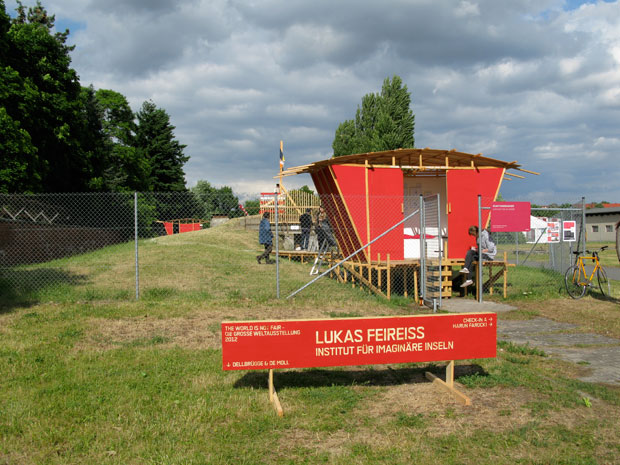
In a physical structure that can simultaneously be a research laboratory and a workshop, the Berlin architect Lukas Feireiss explores the interpretations given to fictional islands in works such as Plato’s „Atlantis“, Thomas More’s „Utopia“, Daniel Defoe’s „Robinson Crusoe“, or William Golding’s „Lord of the Flies“. Under his direction, pupils from Neukölln and Tempelhof designed their ideas of the island and their transposition into the practice of spatial design.
In einer Raumstruktur, die gleichzeitig Forschungslabor und Werkstatt sein kann, erkundete der Berliner Architekt Lukas Feireiss die Interpretationen, die fiktive Inseln in Werken wie Platons „Atlantis“, „Utopia“ von Thomas Morus, Daniel Defoes „Robinson Crusoe“ oder „Herr der Fliegen“ von William Golding erfahren haben. Unter seiner Anleitung entwarfen Schülerinnen und Schüler aus den Stadtteilen Neukölln und Tempelhof ihre Vorstellungen vom Eiland und ihrer Umsetzung in die Praxis der Raumgestaltung.
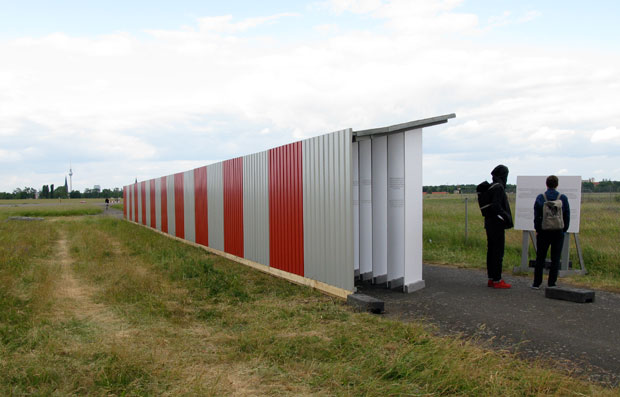
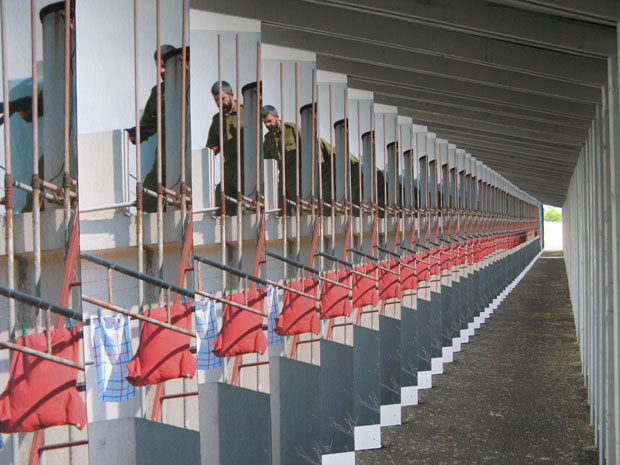
The installation „Double Shooting“ by Rabih Mroué is a re-enactment of a video clip from the ongoing Syrian revolution. It is a tunnel of 45 meters long, consists of 72 frames that make a stop motion sequence, calculated as 4 frames per second. In order to see the video in real time, we should try to time our run from the entrance of the installation to the exit in 18 seconds. On the other side is a text spread on each board. It reflects on the act of photographic documentation in Syria as ›Now and Here‹ and its relationship with death, and how we perceive these photos ›Now but There‹…
Die Installation „Double Shooting“ von Rabih Mroué ist das Reenactment eines jener Videoclips, die während der Revolution in Syrien entstanden sind. Sie besteht aus 72 Plakatwänden mit vergrößerten Standbildern, die zu einem 45 Meter langen Tunnel gruppiert sind. Daraus ergibt sich eine Filmsquenz in Zeitlupe, die auf vier Bildrahmen pro Sekunde kalkuliert ist. Wenn wir das Video in Echtzeit sehen möchten, sollten wir versuchen, den Weg vom Eingang der Installation bis zum Ausgang innerhalb von 18 Sekunden entlangzulaufen. Auf der anderen Seite jeder Stellwand, an der ein Plakate angebracht ist, wird jeweils ein Text zu lesen sein. Er reflektiert den Akt der fotografischen Dokumentation in Syrien als ein ›Now and Here‹, seine Verbindung mit dem Tod, und unsere Wahrnehmung dieser Bilder als ein ›Now, but There‹…
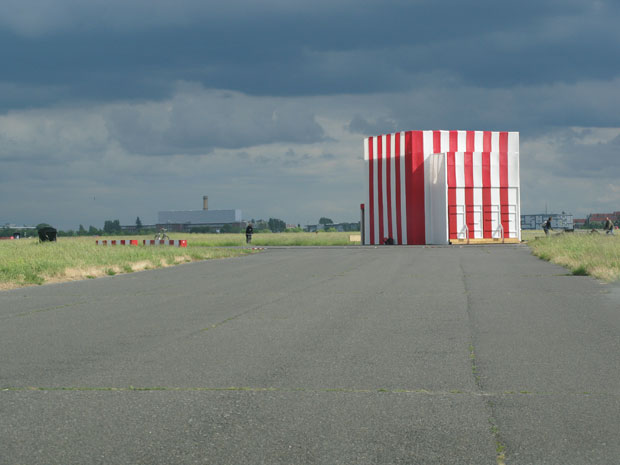
In his pavillion the Dutch conceptual artist Willem de Rooij presentes a sound installation from materials that were recorded at a camel farm in Egypt near the Libyan border. Tacitly alluding to the history of the “human zoos”, Willem de Rooij is creating a framework for presenting fleeting, semantically unstable sound events, which grapple with the exhibition situation as such, the techniques of objectifying cultural artefacts, and the production of the exotic.
Der niederländische Konzeptkünstler Willem de Rooij präsentierte in seinem Pavillon eine Soundinstallation aus Material, das auf einer nahe der libyschen Grenze gelegenen Kamelfarm in Ägypten aufgenommen wurde. Unter stillschweigender Anspielung auf die Geschichte der „Human Zoos“ schafft Willem de Rooij einen Präsentationsrahmen für flüchtige, semantisch instabile Klangereignisse, der sich mit der Ausstellungssituation als solcher, den Techniken der Vergegenständlichung kultureller Artefakte und der Herstellung des Exotischen auseinandersetzt.
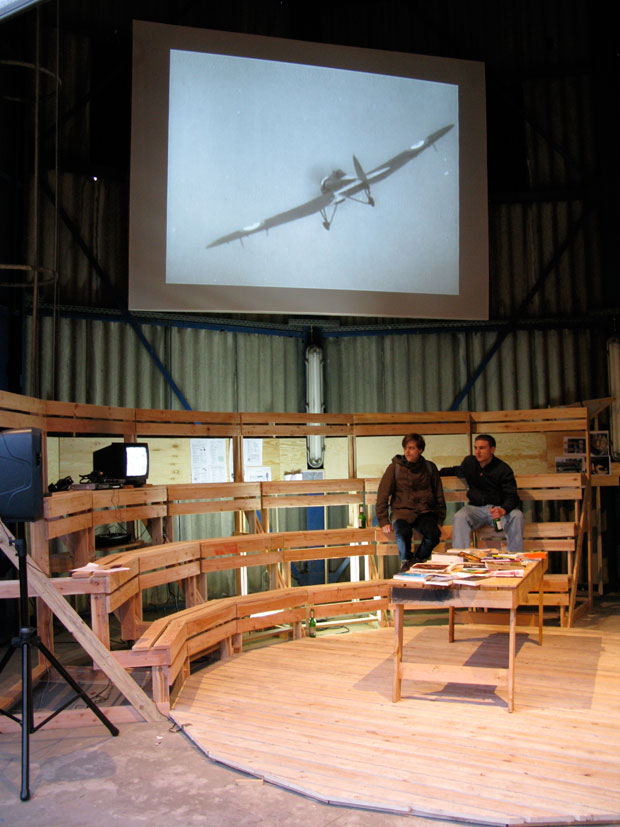
The „Institut für Raumexperimente“ sets up its spaces for the entire time-span of the exhibition in the balloon hall remodeled for this purpose, an existing building at the former Tempelhof Airport. Under the title “Translation Acts”, students are curating a variety of lectures, workshops, performances, and interventions in collaboration with the teaching staff.
Das „Institut für Raumexperimente“ verlegt seine Räumlichkeiten für den gesamten Ausstellungszeitraum in die für diesen Zweck umgebaute Ballonhalle, einem der Bestandsgebäude auf dem ehemaligen
Flughafen Tempelhof. Unter dem Titel „Translation Acts“ kuratieren Studentinnen und Studenten gemeinsam mit dem Lehrpersonal eine Vielzahl von Vorträgen, Workshops, Performances und Interventionen.

In the borderlands between kitsch and decay, machina eX is staging an apocryphal universe that ought to stay concealed, but that gets revealed time and again. We’re breaking in and sliding down into an adventure that oscillates between the fantasy of the end of the world, an expedition, and a theme park.
Im Grenzbereich von Kitsch und Fäulnis inszenieren machina eX ein apokryphes Universum, das verdeckt bleiben soll, sich aber immer wieder offenbart. Wir brechen ein und rutschen hinab, in ein Abenteuer, das zwischen Weltuntergangsfantasie, Entdeckungsreise und Erlebnispark oszilliert.
Dries Verhoeven: Fare thee well!
Anyone looking through one of the optical display devices on an observation tower at the far southern end of the former airport, where the circle rail and the A 100 circle in peaceful accord, will see a running LED text that is barely visibly to the naked eye. It is a testament to the time in which we live, and a farewell to all the people, values, and objects that we have already lost, or that we will soon have to part with. A frightened Europe is holding onto its purses, and the entry doors are shut tight. At the horizon appears a new time full of imponderabilities.
Dries Verhoeven: Fare thee well!
Wer auf einem Aussichtsturm im tiefsten Süden des ehemaligen Flugfeldes, wo die Ringbahn und die A 100 in friedlicher Eintracht ihre Kreise ziehen, durch eines der optischen Sichtgeräte schaut, erblickt eine mit dem bloßen Auge kaum wahrnehmbare LED-Laufschrift. Sie ist das Testament der Zeit, in der wir leben, und ein Lebewohl an alle Menschen, Werte und Gegenstände, die uns bereits verloren gegangen sind, oder von denen wir uns bald verabschieden werden müssen. Ein verängstigtes Europa hält die Geldbörsen und die Eingangstüren fest verschlossen. Am Horizont erscheint eine neue Zeit voller Unwägbarkeiten.
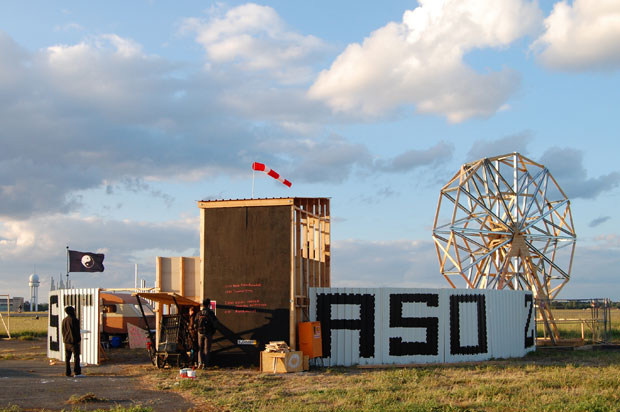
Under the title “52.4697°N 13.396°E”, filmmaker Branca Prlić and the actor, musician, and director Tamer Yiğit are creating an assembly point for people without permanent residence. In parti
cular, it is often the Sinti and Roma from Rumania or Bulgaria who are forced into permanent mobility, people who have moved further west since these two states entered the European Union. They are part of an economic migration not unlike many others in history.
Unter dem Titel „52.4697°N 13.396°E“ schaffen die Filmmemacherin Branca Prlić und der Schauspieler, Musiker, Regisseur Tamer Yiğit eine Versammlungsstätte für Menschen ohne festen Wohnsitz. Zu permanenter Mobilität gezwungen sind insbesondere oft Sinti und Roma aus Rumänien oder Bulgarien, die es seit dem Beitritt dieser Staaten in die Europäische Union nach Westen zieht. Sie sind Teil einer Armutswanderung, wie es sie in der Geschichte häufig gegeben hat.
